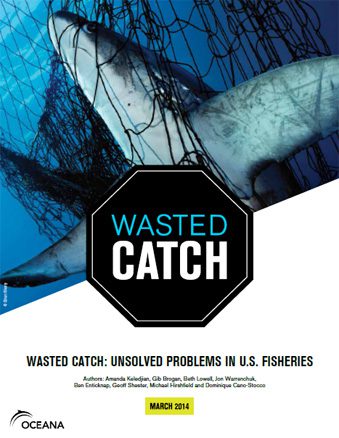Report | March, 2014
Wasted Catch: Unsolved Problems in U.S. Fisheries
CORRECTION: This report referenced a bycatch rate of 40% as determined by Davies et al. 2009, however that calculation used a broader definition of bycatch than is standard. According to bycatch as defined in this report and elsewhere, the most recent analyses show a rate of approximately 10% (Zeller et al. 2017; FAO 2018).
In the United States, despite strong management measures and conservation initiatives in some regions, bycatch remains a persistent problem for far too many fisheries. Some fisheries discard more fish at sea than what they bring to port, in addition to injuring and killing thousands of whales, dolphins, seals, sea turtles and sharks each year.
While bycatch data is often outdated and inaccurate, researchers estimate that 17-22 percent of U.S. catch is discarded every year, according to the best available data. Bycatch in the U.S. could amount to 2 billion pounds every year, equivalent to the entire annual catch of many other fishing nations around the world. One of the biggest concerns about bycatch is that the severity of the problem in many regions and fisheries still remains unknown. The National Marine Fisheries Service rarely reports comprehensive bycatch data and in fact has not published a nationwide estimate using data more recent than 2005—and has no intention of updating its estimates until 2017. In short, bycatch harms ocean wildlife, wastes important food resources and undercuts the economic success of our nation’s fisheries.
- Press Release
- Bios of Oceana experts: Amanda Keledjian (Report Author & Marine Scientist), Ben Enticknap (Pacific Campaign Manager & Senior Scientist), Dominique Cano-Stocco (Campaign Director), Geoff Shester (California Program Director), Gib Brogan (Fisheries Campaign Manager), Jon Warrenchuk (Senior Scientist & Campaign Manager)
- Oceana b-roll video available upon request. Please contact Amelia Vorpahl (202-467-1968, avorpahl@oceana.org) or Dustin Cranor (954-348-1314, dcranor@oceana.org) for more information.
- General Bycatch Photos
- California Drift Gillnet photos
- Infographic
- Brochure
- Fisheries Map
- Media Contact Information (Dustin Cranor ( dcranor@oceana.org | 954-348-1314 (cell)) and Amelia Vorpahl ( avorpahl@oceana.org | 202-467-1968, 202-476-0632 (cell))




